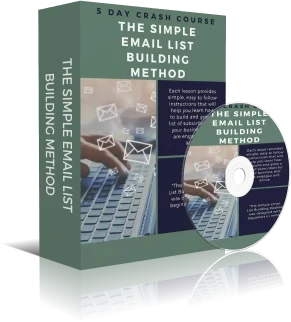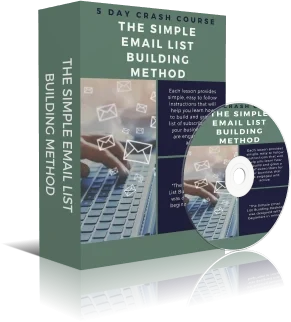
Newsletter Sign Up
With FREE List Building Course!
Our newsletter contains useful tips, notification of events and offers. You may cancel your subscription at anytime. Plus receive The Simple Email List Building Method 5 day crash course FREE when you subscribe!.
Niche Selection Simplified: A Beginner’s Guide to Finding A Profitable Online Niche
15 June 2023
Table of Content
- Introduction to Finding a Profitable Online Niche
- What is a Niche?
- Understanding the Benefits of Niche Marketing
- How to Identify a Profitable Niche
- Strategies for Niche Marketing Success
- Monetization Strategies for Your Niche Business
- Create a Membership or Subscription Model
- Finding A Profitable Online Niche FAQ’s

Introduction to Finding a Profitable Online Niche
In this beginner’s guide to finding a profitable online niche, we will explore the fascinating world of niches and how they can pave the way for your online success.
What is a Niche?

Befor we go finding a profitable online niche we need to understand what a niche actually is.
In the world of entrepreneurship and digital marketing, understanding what a niche is, and its significance is fundamental to your success.
Let’s dive deeper into this concept and demystify what a niche truly entails.
At its core, a niche refers to a specialized segment within a broader market. Instead of trying to appeal to everyone, you narrow your focus to a specific target audience with distinct needs, interests, or characteristics.
By catering to this specific group, you can tailor your offerings to address their pain points and desires more effectively. This approach allows you to stand out from the competition and build stronger connections with your audience.
To grasp the concept better, let’s take an example.
Imagine you are interested in the fitness industry.
Instead of entering the overcrowded and highly competitive market by selling generic fitness products, you decide to carve out a niche by focusing on “home workout equipment for busy moms.”
By specializing in this niche, you can create and curate products that specifically cater to the needs of busy moms who want to stay fit conveniently from the comfort of their homes.
Now, you might be wondering, why should you choose a niche instead of targeting a broad market?
Let’s explore the advantages of niche marketing:
- Establish Yourself as an Authority:
In a competitive online landscape, establishing yourself as an authority is essential.
When you specialize in a specific niche, you position yourself as an expert in that area.
By consistently delivering valuable content, products, or services that cater to your niche audience’s needs, you gain credibility and trust.
Over time, this can lead to a loyal following and a reputation as a go-to resource within your niche.
- Connect with Your Target Audience:
By focusing on a niche, you have the opportunity to deeply understand and connect with your target audience.
As you cater to their specific needs and desires, you develop a rapport and build relationships.
This allows you to communicate more effectively, tailor your marketing messages, and create products or services that truly resonate with your audience.
By honing in on their pain points, aspirations, and interests, you can address them directly and become their preferred choice within the niche.
- Increase Profitability:
While it may seem counterintuitive, targeting a smaller, specialized audience can often lead to increased profitability.
In broad markets, the competition can be fierce, making it challenging to differentiate yourself and charge premium prices.
However, within a niche, there is often less competition, allowing you to stand out more easily.
Moreover, when you cater to a specific audience’s unique needs, they are often willing to pay a premium for the specialized solutions you provide.
This can lead to higher profit margins and a more sustainable business model.
By now, you can see the immense value that choosing a niche can bring to your online business.
It allows you to position yourself as an authority, deeply connect with your target audience, and increase your profitability by delivering specialized solutions.
Niche selection
When selecting a niche, it’s important to strike a balance between specificity and market size.
Choosing a niche that is too narrow may limit your potential customer base, while targeting a niche that is too broad might lead to increased competition and difficulty in standing out.
Finding the sweet spot where your niche is specific enough to cater to a distinct audience but broad enough to provide ample business opportunities is crucial
To identify a niche that aligns. with your interests and has potential for profitability, start by reflecting on your own passions, hobbies, and expertise.
Consider the areas where you have genuine enthusiasm and knowledge.
This personal connection to your niche will not only make your entrepreneurial journey more enjoyable but also give you a competitive advantage as you understand the needs and desires of your target audience from firsthand experience.
Validation
Once you have identified your areas of interest, it’s time to validate the market demand for potential niches. Start by conducting thorough market research using a variety of online tools and resources.
Use search engines to explore relevant keywords and see if there is a significant volume of searches related to your niche. This indicates the level of interest and potential demand within the market.
Social media platforms are also valuable sources of information.
Look for groups, communities, or pages dedicated to your potential niche.
Engagement
Assess the level of engagement, discussions, and interactions happening within these online spaces.
This will give you insights into the active audience and their interests, which can guide your decision-making process.
Additionally, online forums and discussion boards related to your niche are treasure troves of information. Browse through these platforms to understand the questions, concerns, and problems that people within your potential niche are seeking solutions for.
This will help you shape your offerings to directly address these pain points.
Competition
While researching your potential niche, pay attention to the competition as well.
Analyze existing businesses operating within the niche and assess their strengths, weaknesses, and unique selling propositions.
This analysis will help you identify gaps and opportunities where you can differentiate yourself and provide a unique value proposition to your audience.
Keep up to date
It’s important to note that niches can evolve over time, and trends may shift.
Stay informed about emerging trends, changing consumer preferences, and advancements within your chosen niche.
By staying up-to-date with industry developments, you can adapt your strategies and offerings to remain relevant and capture new opportunities as they arise.
Summary so far..
In conclusion, understanding what a niche is and the benefits it offers is crucial for your success as an entrepreneur.
By narrowing your focus and catering to a specific target audience, you can establish yourself as an authority, connect deeply with your customers, and increase profitability.
Take the time to explore your interests, conduct thorough market research, and identify a niche that aligns with your passions and has potential for growth.
Remember, finding the right niche is the foundation upon which you can build a thriving and sustainable online business.
Understanding the Benefits of Niche Marketing

One of the most significant advantages of niche marketing is the ability to deeply understand and connect with your target audience.
By catering to a specific group’s unique needs and desires, you can develop a stronger rapport and build meaningful relationships with your customers.
Let’s explore the benefits of niche marketing in more detail:
1. Tailored Communication:
When you have a well-defined niche, you can communicate with your audience in a more personalized and targeted manner.
You understand their preferences, pain points, and aspirations, allowing you to create marketing messages that resonate deeply with them.
By speaking directly to their needs and desires, you increase the chances of capturing their attention and engaging them in a meaningful way.
For example, suppose you operate a business that offers eco-friendly pet products specifically designed for environmentally conscious pet owners.
With a niche focus, you can create marketing campaigns that highlight the sustainable materials used in your products, their positive impact on the environment, and how they contribute to the health and well-being of pets.
This tailored communication establishes a connection with your target audience, showing that you understand their values and priorities.
2. Product/Service Customization:
Niche marketing allows you to customize your products or services to cater to the unique requirements of your target audience.
By understanding their specific needs and preferences, you can develop offerings that align perfectly with their expectations.
This customization sets you apart from competitors who offer more generalized solutions and positions you as a provider of specialized solutions tailored to their niche.
Continuing with the eco-friendly pet products example, you can focus on creating items like biodegradable pet waste bags, organic pet food, and sustainable pet toys.
By emphasizing the eco-friendly features, you offer pet owners a distinct value proposition that aligns with their desire to minimize their environmental impact.
Customizing your offerings to meet the specific needs of your niche audience boosts customer satisfaction and loyalty.
3. Reduced Competition:
Targeting a niche often means facing less competition compared to broader markets.
In a crowded market, it can be challenging to stand out and capture the attention of potential customers.
However, by honing in on a specific niche, you carve out a space for yourself where competition is less intense.
For instance, if you decide to start a business selling handmade jewelry, competing in the general jewelry market may be daunting.
However, if you narrow down your focus to creating unique, handcrafted silver jewelry inspired by Norse mythology, you enter a niche with fewer competitors.
This reduced competition allows you to differentiate your products more easily, gain visibility, and attract customers who are specifically interested in Norse mythology-themed jewelry.
4. Enhanced Customer Loyalty:
Niche marketing fosters a sense of loyalty among your customers.
When you cater to their specific needs and preferences, you create a stronger bond and develop a community around your brand.
Customers who find value in your niche offerings are more likely to become repeat buyers and advocates for your business.
Consider the niche of natural skincare products for individuals with sensitive skin.
By formulating gentle, fragrance-free products and providing educational resources on skincare for sensitive skin, you build trust and loyalty among your customers.
They appreciate your expertise and the tailored solutions you offer, making them more likely to stick with your brand and recommend it to others within their niche.
5. Opportunities for Expert Positioning:
Focusing on a niche allows you to establish yourself as an expert in your field.
By consistently delivering valuable content, products, or services tailored to your niche audience, you build credibility and trust.
Over time, this positions you as a go-to resource within your niche and opens doors for collaboration, speaking engagements, and other opportunities to showcase your expertise.
For example, if you specialize in the niche of sustainable fashion, you can create content that educates your audience about the environmental impact of fast fashion, provide tips on building a sustainable wardrobe, and highlight ethical fashion brands.
By consistently sharing valuable insights and expertise, you become a trusted authority in the sustainable fashion niche.
As your reputation as an expert grows, you may be invited to speak at industry conferences or collaborate with other sustainable fashion brands.
These opportunities not only raise your profile but also expand your reach within the niche, attracting more customers and establishing your brand as a leader in the field.
6. Increased Return on Investment (ROI):
Niche marketing can lead to a higher return on investment compared to broad marketing approaches.
When you focus your resources on a specific target audience, your marketing efforts become more efficient and cost-effective.
By eliminating the need to reach a mass market, you can allocate your budget towards strategies and channels that specifically cater to your niche audience.
For instance, instead of spending a significant amount on generic advertising campaigns, you can invest in targeted online advertisements or influencer partnerships that directly reach your niche audience.
This targeted approach ensures that you are reaching the right people with a higher likelihood of conversion, resulting in a better return on your marketing investment.
7. Adaptability and Growth Potential:
Niche markets often have room for expansion and diversification.
Once you establish a strong presence and loyal customer base within your initial niche, you can explore opportunities to expand your offerings or cater to related niches.
This adaptability allows you to stay agile and evolve your business as consumer needs and market trends change over time.
For example, if you initially focus on offering eco-friendly pet products, you can gradually expand your product line to include pet grooming services or eco-friendly pet accessories.
By leveraging the trust and loyalty you have already built within your niche, you can tap into new markets while retaining your core audience.
In summary….
In conclusion, niche marketing tactics offers numerous benefits for entrepreneurs and small business owners.
By understanding the unique advantages it provides, you can effectively position your business, build strong customer relationships, reduce competition, and achieve higher returns on your marketing investments.
Embracing niche marketing can propel your business towards success in the online landscape.
How to Identify a Profitable Niche

Identifying a profitable niche is a crucial step in building a successful online business.
While it may seem challenging at first, with the right approach and mindset, you can uncover niche opportunities that align with your interests and have the potential for profitability.
Here are some strategies to help you in the process:
1. Identify Your Passions and Interests:
Start by exploring your passions and interests.
Consider the topics or industries that genuinely excite you.
Your passion for a particular subject will drive your motivation and dedication, making it easier to navigate the challenges that come with building a business.
For example, if you have a deep interest in fitness and healthy living, you could explore niches within the wellness industry, such as specialized workout programs, vegan nutrition, or mindfulness practices.
By aligning your business with your passions, you’ll not only enjoy the work you do but also connect more authentically with your target audience.
2. Research Market Demand:
While following your passions is important, it’s equally crucial to ensure that there is market demand for your chosen niche.
Conduct thorough market research to evaluate the potential size and profitability of the niche.
Start by using online tools like Google Trends, keyword research tools, and industry reports to identify the popularity and search volume of relevant keywords within your niche.
Look for signs of growth or consistent interest in the market.
Additionally, browse through forums, social media groups, and online communities related to your niche.
Pay attention to the discussions, questions, and challenges that people are sharing.
This will give you insights into their needs and help you identify gaps or opportunities that you can address with your business.
3. Assess Competition:
While it’s natural to face competition in any niche, it’s important to assess the level of competition and evaluate your ability to differentiate yourself.
Analyze the existing businesses in your niche and identify their strengths, weaknesses, and unique selling points.
Consider the following questions:
– How saturated is the market with similar businesses?
– Are there any gaps or underserved segments within the niche?
– Can you offer a unique perspective, better quality, or additional value compared to your competitors?
Finding a balance between competition and market demand is crucial.
A niche with high demand and low competition can provide a significant opportunity for niche business growth and profitability.
4. Define Your Target Audience:
To succeed in a niche, you must have a clear understanding of your target audience.
Define the demographics, psychographics, and behaviors of your ideal customers.
This will help you tailor your marketing efforts and create products or services that directly address their needs.
Conduct market research surveys, engage with your audience on social media platforms, and analyze competitor customer reviews to gain insights into your target audience’s preferences, pain points, and desires.
For instance, if your niche is in the beauty industry, you may find that your target audience consists of young professionals who prioritize natural and organic skincare products due to their concern for the environment and their skin’s health.
Understanding these characteristics will allow you to develop products and marketing messages that resonate with them specifically.
5. Validate Your Niche:
Before fully committing to a niche, it’s essential to validate its potential profitability.
This involves testing your ideas and assumptions to ensure that there is sufficient demand and willingness to pay within your target audience.
Consider these validation methods:
– Create a minimum viable product (MVP) or offer a pilot service to gauge interest and gather feedback.
– Conduct pre-launch surveys or use landing pages to assess interest and collect email sign-ups from potential customers.
– Run small-scale advertising campaigns to test the response and conversion rates for your product or service.
Validation helps you make informed decisions about investing time, effort, and resources into your chosen niche.
It allows you to pivot or refine your business idea based on real-world feedback, ultimately increasing your chances of success.
6. Analyze Profitability Potential:
Beyond market demand, it’s crucial to assess the profitability potential of your chosen niche. Consider the following factors:
– Profit Margins: Evaluate the pricing structure and profit margins within your niche. Are there opportunities to offer premium or higher-priced products or services that can generate a healthy profit margin?
– Repeat Business: Consider whether your niche lends itself to repeat business or recurring revenue models. For example, if you’re in the subscription box niche, recurring monthly subscriptions can provide a steady stream of revenue.
– Upselling and Cross-selling Opportunities: Look for potential upselling or cross-selling opportunities within your niche. Can you offer complementary products or services that increase the average transaction value?
– Longevity and Growth Potential: Assess the long-term sustainability and growth potential of your niche. Is it a passing trend or something that has long-term viability? Will the niche continue to evolve and attract new customers over time?
By evaluating these factors, you can gain a clearer understanding of the financial viability of your niche and make informed decisions about your business strategy.
7. Stay Agile and Adapt:
Remember that niches can evolve and change over time. Consumer preferences, market trends, and technologies can shift, requiring you to stay agile and adapt your business to remain relevant.
Continuously monitor your niche, engage with your audience, and stay updated on industry developments.
Be open to feedback and be willing to adjust your offerings or strategies as needed.
This adaptability will position you for long-term success within your chosen niche.
So far…
In conclusion, identifying a profitable niche requires a combination of passion, market research, understanding your target audience, and assessing the potential for profitability.
By following these strategies and staying attuned to market dynamics, you can discover a niche that aligns with your interests and has the potential to be a profitable venture.
Remember, the journey of finding the right niche may involve some experimentation and iteration, but the rewards of establishing a thriving business within a specialized market are well worth it.
Strategies for Niche Marketing Success

Once you have identified a profitable niche for your online business, it’s time to implement effective strategies that will set you up for success and ultimately niche market monetization.
Niche marketing requires a targeted approach to reach and engage your specific audience. Here are some key profitable niche strategies to consider:
1. Develop a Compelling Value Proposition:
Craft a clear and compelling value proposition that communicates the unique benefits and value your business offers to your niche audience.
Your value proposition should address their specific pain points, desires, or challenges and highlight how your products or services provide the ideal solution.
For example, if your niche is eco-friendly home cleaning products, your value proposition may emphasize the use of natural, non-toxic ingredients that are safe for both the environment and households.
This value proposition resonates with environmentally conscious consumers seeking effective cleaning options that align with their values.
2. Build a Strong Brand Identity:
In a niche market, building a strong brand identity is crucial for standing out and establishing trust with your audience.
Develop a brand that reflects the values, aspirations, and personality of your niche audience.
This includes designing a visually appealing and cohesive brand identity, creating a compelling brand story, and consistently communicating your brand’s unique voice and messaging.
Use your brand to create a sense of community and connection within your niche. Engage with your audience through social media platforms, blog posts, and newsletters.
Foster two-way communication, listen to their feedback, and actively involve them in shaping your brand.
3. Create High-Quality, Niche-specific Content:
Content marketing plays a vital role in niche marketing success.
Produce high-quality, niche-specific content that educates, entertains, and engages your audience.
Develop a content strategy that aligns with your niche’s interests and pain points.
For instance, if your niche is organic gardening, you could create content such as blog posts or videos on topics like organic pest control, companion planting, or creating a sustainable garden.
By providing valuable and relevant content, you position yourself as a trusted authority in your niche and attract organic traffic from search engines and social media platforms.
Optimize your content with relevant keywords and use a mix of formats, such as written articles, videos, podcasts, or infographics, to cater to different audience preferences.
Encourage social sharing and interaction with your content to expand your reach within the niche.
4. Leverage Social Media:
Social media platforms offer valuable opportunities to connect with your niche audience and promote your business.
Identify the platforms where your target audience is most active and develop a strategic presence on those channels.
Create engaging and shareable social media content that aligns with your niche. Use a mix of informative, entertaining, and promotional content to keep your audience interested and involved.
Encourage user-generated content and engage in conversations with your followers to foster a sense of community.
Consider partnering with influencers or micro-influencers within your niche to expand your reach.
Collaborating with influencers who have an established following in your niche can help you gain credibility, reach new potential customers, and generate buzz around your products or services.
5. Implement Targeted Advertising:
Targeted advertising allows you to reach your niche audience with precision.
Use platforms like Google Ads, Facebook Ads, or Instagram Ads to create highly targeted campaigns that focus on specific demographics, interests, or behaviors relevant to your niche.
Refine your targeting parameters based on the characteristics of your niche audience.
This includes factors such as age, location, interests, and online behaviors.
By reaching the right audience with your ads, you can increase the chances of conversions and maximize your return on investment.
6. Cultivate Customer Relationships:
Nurture relationships with your niche customers by providing exceptional customer service and personalized experiences.
Aim to go above and beyond to exceed their expectations.
Respond promptly to inquiries or feedback, offer personalized recommendations based on their preferences, and show genuine care for their satisfaction.
Implement loyalty programs or exclusive offers for your niche customers to incentivize repeat purchases and foster loyalty.
By treating your customers as valued individuals within your niche, you build trust, strengthen your brand reputation, and increase the likelihood of positive word-of-mouth referrals.
7. Collaborate with Niche Partners:
Collaborating with other businesses or individuals within your niche can provide mutual benefits and expand your reach.
Identify potential partners who offer complementary products or services that align with your niche audience’s needs.
For example, if you have an online store specializing in organic skincare products, you could collaborate with a wellness blogger who shares similar values and has a dedicated following in the wellness niche.
This collaboration can involve co-creating content, hosting joint events or promotions, or cross-promoting each other’s products or services.
By partnering with niche influencers or businesses, you tap into their established audience and gain exposure to new potential customers who are already interested in your niche.
8. Continuously Monitor and Adapt:
Niche markets can evolve rapidly, so it’s essential to continuously monitor market trends, consumer preferences, and the competitive landscape.
Stay updated on industry developments, keep an eye on your competitors’ strategies, and gather feedback from your niche audience.
Regularly analyze your marketing efforts, including website analytics, social media metrics, and conversion rates.
Identify what’s working well and where there may be room for improvement. Use data-driven insights to optimize your strategies and make informed decisions about refining your niche marketing approach.
Be willing to adapt and pivot when necessary.
As your niche evolves, consumer needs and preferences may change.
Stay agile and be ready to adjust your offerings, messaging, or marketing channels to remain relevant and continue meeting your niche audience’s expectations.
In summary….
In conclusion, implementing these strategies will help you succeed in niche marketing.
By developing a compelling value proposition, building a strong brand identity, creating niche-specific content, leveraging social media, implementing targeted advertising, cultivating customer relationships, collaborating with niche partners, and staying adaptable, you can establish your business as a trusted authority within your niche and attract a loyal customer base.
Remember, niche marketing requires a focused and tailored approach, but the rewards of catering to a specific audience’s needs and desires are well worth the effort.
Monetization Strategies for Your Niche Business

Once you have identified a profitable niche and implemented effective marketing strategies, it’s time to explore various monetization methods to generate niche business revenue.
Here are some key monetization strategies to consider:
1. Sell Physical Products:
One of the most common ways to monetize a niche business is by selling physical products. Develop a range of products that cater specifically to your niche audience’s needs and preferences.
Ensure that the products align with your brand values and offer unique features or benefits that set them apart from competitors. Remember niche branding and monetization are intrinsically linked.
For example, if your niche is organic baby products, you could sell items like organic baby clothing, eco-friendly diapers, or natural baby skincare products.
Consider creating product bundles or subscription boxes tailored to specific needs within your niche.
Set up an e-commerce website to showcase and sell your products. Optimize your product listings with compelling descriptions, high-quality images, and customer reviews.
Provide a seamless and secure checkout process to enhance the customer experience.
2. Offer Digital Products:
Digital products provide an opportunity to leverage your expertise and knowledge within your niche while generating passive income.
Develop digital products that offer value and convenience to your audience.
Some popular digital products in various niches include e-books, online courses, templates, guides, software, or membership programs.
For instance, if your niche is graphic design, you could create an online course on advanced graphic design techniques or offer a membership program that provides exclusive design resources and tutorials.
Promote your digital products through your website, email marketing campaigns, and social media platforms.
Consider providing free samples or previews to build interest and trust with your audience.
Continuously update and improve your digital products to provide ongoing value and encourage repeat purchases.
3. Offer Services:
If you have specific skills or expertise within your niche, consider offering services that cater to your audience’s needs.
This can include consulting, coaching, personalized advice, or specialized services.
For example, if your niche is financial planning for young professionals, you could offer one-on-one financial coaching sessions or create personalized financial plans tailored to individual clients’ goals and circumstances.
Promote your services through your website, social media platforms, and industry-specific forums or communities.
Highlight your expertise and the benefits clients can expect from working with you.
Consider offering introductory packages or limited-time promotions to attract new clients and build your reputation within the niche.
4. Implement Affiliate Marketing:
Affiliate marketing is a popular monetization method in which you earn a commission by promoting and recommending other businesses’ products or services within your niche.
Identify reputable affiliate programs or partnerships that align with your niche and complement your offerings.
For instance, if your niche is sustainable fashion, you could partner with eco-friendly clothing brands and promote their products to your audience.
When someone makes a purchase through your affiliate link, you earn a commission.
Integrate affiliate links strategically within your content, such as product reviews, gift guides, or tutorials.
Be transparent with your audience about your affiliate relationships and only promote products or services that you genuinely believe in.
Focus on providing valuable information and recommendations to build trust with your audience.
5. Ad Revenue and Sponsorships:
As your niche business grows and attracts a significant audience, you can explore generating revenue through advertisements and sponsorships.
Display relevant ads on your website or blog using advertising networks like Google AdSense or niche-specific ad networks.
Additionally, seek out sponsorships from businesses or brands that align with your niche.
Collaborate with them to create sponsored content, sponsored social media posts, or brand partnerships.
Ensure that the sponsorships are authentic and add value to your audience’s experience.
Maintain transparency with your audience regarding sponsored content or ads by clearly labeling them as such.
Focus on partnering with brands that resonate with your audience and share similar values to maintain the trust you’ve established.
6. Create a Membership or Subscription Model:
Consider offering a membership or subscription model to provide exclusive access to premium content, resources, or perks for your niche audience.
This monetization strategy can provide recurring revenue and foster a sense of community among your most dedicated followers.
For example, if your niche is photography, you could create a membership site that offers access to advanced photography tutorials, a private community forum, exclusive discounts on photography equipment, and personalized feedback on members’ work.
Offer different membership tiers or subscription levels with varying benefits and pricing options.
Continuously deliver valuable content and engage with your members to encourage retention and attract new subscribers.
Implement a secure payment system and ensure a seamless user experience within your membership platform.
Regularly evaluate and improve the offerings based on member feedback and evolving needs within your niche.
See Section 6: Create a Membership or Subscription Model
7. Host Workshops or Events:
If your niche lends itself to in-person or virtual gatherings, consider hosting workshops, seminars, or events related to your area of expertise.
These events can provide an additional revenue stream and further establish your authority within the niche.
For example, if your niche is sustainable living, you could organize workshops on eco-friendly home practices, zero-waste lifestyle, or organic gardening.
Offer tickets or registrations for these events and provide participants with valuable knowledge, hands-on experiences, and networking opportunities.
Promote your workshops or events through your website, social media platforms, and relevant industry forums or event listing platforms.
Consider collaborating with other experts or businesses within your niche to broaden the appeal and expertise offered during the events.
Ensure that the events align with your brand values and deliver a memorable and enriching experience for attendees.
Collect feedback and testimonials to further enhance your reputation and attract future participants.
8. Explore Licensing or Product Extensions:
If your niche business has gained recognition and success, you can explore licensing your brand or products to other businesses or consider expanding your product line.
Licensing allows other companies to use your brand name, logo, or intellectual property to create and market products within your niche.
This can provide additional revenue streams without the need for extensive production or distribution.
Consider collaborations or partnerships with established companies in related industries to expand your product offerings.
For instance, if your niche is healthy cooking, you could collaborate with a kitchenware brand to create a line of branded cooking utensils or appliances.
Ensure that any licensing agreements or product extensions align with your brand values and maintain the quality and reputation you’ve established.
In summary so far…
In conclusion, online business monetization requires a thoughtful approach and a mix of strategies that align with your niche audience’s preferences and needs.
By selling physical products, offering digital products or services, implementing affiliate marketing, exploring ad revenue and sponsorships, creating membership or subscription models, hosting workshops or events, and considering licensing or product extensions, you can generate revenue while delivering value to your niche audience.
Continuously monitor and adapt your monetization strategies based on market trends, audience feedback, and the evolving landscape of your niche to ensure long-term success.
In short these monetization models for niche businesses will serve you well.
Create a Membership or Subscription Model

Creating a membership or subscription model is an effective monetization strategy that allows you to provide exclusive content, resources, and perks to your niche audience.
By offering a membership program, you not only generate recurring revenue but also foster a sense of community and provide added value to your most dedicated followers.
Here’s how you can develop and implement a successful membership or subscription model:
- Define Your Membership Tiers or Subscription Levels: Begin by defining the different membership tiers or subscription levels you will offer. Consider the needs, preferences, and budget of your niche audience when creating these options. Each tier should provide increasingly valuable benefits as you move up the ladder.
For example, you can have a basic tier that offers access to exclusive content, a middle tier with additional resources and personalized support, and a premium tier that includes one-on-one coaching sessions or VIP perks.
- Determine Your Pricing Strategy: Set your pricing strategy based on the value you provide and the market standards within your niche. Research what competitors or similar businesses charge for similar membership or subscription programs and ensure that your pricing is competitive.
Consider offering different payment options, such as monthly, quarterly, or annual subscriptions, to accommodate different budget preferences. Offering discounts or incentives for longer-term commitments can encourage members to sign up for extended periods.
- Create Exclusive Content and Resources: To attract and retain members, you need to provide high-quality and exclusive content that is not available to non-members. This content can come in various formats, such as videos, tutorials, e-books, podcasts, templates, or webinars.
Ensure that the content aligns with your niche and addresses the specific pain points or interests of your audience.
Regularly update and add new content to keep members engaged and excited about their subscription.
Consider offering additional resources, such as downloadable guides, checklists, or access to industry experts or guest speakers.
Encourage member participation by incorporating interactive elements like discussion forums, Q&A sessions, or live events.
- Build a Community: A strong sense of community is crucial for the success of a membership or subscription program. Provide a platform where members can connect, interact, and support each other. This can be a private online forum, a dedicated social media group, or a community space within your website.
Facilitate discussions, encourage member participation, and foster a positive and supportive environment.
Actively engage with members, respond to their questions and comments, and create opportunities for them to share their experiences and knowledge.
Consider organizing exclusive virtual or in-person events for members, such as webinars, workshops, or networking sessions.
These events allow members to connect with each other and with you, further strengthening the community bonds.
- Offer Personalization and Member Benefits: Make your members feel valued and appreciated by offering personalized experiences and additional benefits. Provide opportunities for one-on-one interactions, such as personalized consultations, coaching sessions, or feedback on their work.
Consider offering member-exclusive discounts on products or services within your niche or partnering with other businesses to provide special offers or perks.
These benefits not only incentivize membership but also reinforce the value proposition of being a member.
- Focus on Retention and Continuous Improvement: Retaining members is just as important as acquiring new ones. Regularly assess the needs and feedback of your members to ensure that you are meeting their expectations. Seek feedback through surveys, polls, or direct communication channels to understand what they find valuable and what improvements can be made.
Continuously improve and expand your membership program based on member feedback and emerging trends within your niche.
Introduce new features, additional content, or enhanced benefits to keep members engaged and excited about their membership.
Monitor key metrics, such as member retention rates, engagement levels, and feedback, to gauge the success of your membership program.
Use this data to identify areas of improvement and make data-driven decisions for optimizing your membership or subscription model.
- Promote and Market Your Membership Program: Once you have developed your membership program, it’s essential to promote and market it effectively to attract new members. Utilize various marketing channels to reach your target audience within your niche.
Promote your membership program on your website prominently, highlighting the benefits and value it offers.
Create compelling landing pages that clearly communicate the features, tiers, and pricing of your membership program.
Use persuasive copywriting techniques to convey the exclusivity and benefits of joining.
Utilize your existing email list to promote your membership program and send targeted email campaigns to engage with potential members.
Craft persuasive and personalized messages that address the pain points and aspirations of your audience.
Leverage the power of social media platforms to generate buzz and excitement around your membership program.
Create engaging and shareable content that showcases the unique offerings and benefits of being a member.
Encourage your existing members to share their experiences and testimonials on social media to amplify your reach and credibility.
Consider collaborating with niche influencers or industry experts who align with your brand and target audience.
Guest appearances or endorsements from influential figures within your niche can significantly increase awareness and drive membership sign-ups.
Utilize paid advertising campaigns, such as Google Ads or social media ads, to target your niche audience and promote your membership program to a wider audience.
Tailor your messaging and targeting parameters to reach those who are most likely to find value in your program.
- Provide Exceptional Member Support: Member support and customer service are crucial for maintaining member satisfaction and retention. Offer timely and responsive support channels, such as email, live chat, or a dedicated support ticket system. Be readily available to address any concerns, answer questions, and provide guidance to your members.
Train your support team or yourself to handle member inquiries and issues with professionalism and empathy.
Create a comprehensive knowledge base or FAQ section to provide self-help resources and minimize support requests.
Regularly communicate with your members through newsletters, updates, or exclusive member-only content.
Keep them informed about new offerings, upcoming events, and any changes or improvements to the membership program.
- Analyze and Adjust: Continuously analyze the performance and effectiveness of your membership program. Track key metrics such as membership growth, churn rate, engagement levels, and member feedback. Utilize web analytics tools, customer surveys, and member feedback to gather insights.
Identify areas of improvement or opportunities for expansion based on member behavior and feedback. Assess the performance of different membership tiers and benefits to ensure they align with the value provided.
Experiment with different strategies and approaches to optimize member acquisition, retention, and engagement.
Stay up-to-date with industry trends and evolving needs within your niche.
Adjust your membership program accordingly to remain relevant and provide ongoing value to your members.
Be adaptable and willing to make changes and improvements based on data and member feedback.
In conclusion, creating a membership or subscription model offers an excellent opportunity to monetize your niche business while providing exclusive value to your audience.
By defining membership tiers, pricing strategically, creating compelling content, building a community, offering personalization and member benefits, focusing on retention, promoting effectively, providing exceptional member support, and analyzing and adjusting as needed, you can develop a thriving membership program that attracts and retains loyal members within your niche.
Remember, nurturing a strong sense of community and delivering continuous value is key to the long-term success of your membership program.
Final Thoughts
In conclusion, monetizing your niche business requires a thoughtful and strategic approach that aligns with the preferences and needs of your target audience.
By implementing a combination of effective strategies and staying true to your niche, you can generate revenue while providing valuable products or services.
Let’s recap the key points covered in this article:
1. Understand Your Niche: Before diving into monetization strategies, it’s essential to thoroughly understand your niche. Conduct market research, identify your target audience, and gain insights into their interests, pain points, and purchasing behavior. This knowledge will guide your monetization efforts and help you deliver solutions that resonate with your audience.
2. Choose the Right Monetization Methods: There are numerous monetization methods available, but not all may be suitable for your niche. Evaluate the options discussed in this article, such as selling physical or digital products, implementing affiliate marketing, exploring ad revenue and sponsorships, creating a membership or subscription model, hosting workshops or events, and considering licensing or product extensions. Select the methods that align with your niche, audience, and business goals.
3. Provide Value: Regardless of the monetization methods you choose, delivering value to your audience is paramount. Your products, services, or content should solve their problems, fulfill their needs, or entertain them. Focus on creating high-quality offerings that stand out in your niche and exceed customer expectations. Value-driven approaches lead to customer satisfaction, loyalty, and increased revenue opportunities.
4. Build Relationships and Trust: Building strong relationships and establishing trust with your audience is crucial for long-term success. Engage with your audience through social media, email newsletters, blog comments, or other communication channels. Respond to their inquiries, provide personalized support, and listen to their feedback. By fostering a sense of connection and demonstrating your expertise, you can develop a loyal following and attract new customers.
5. Continuously Adapt and Improve: The digital landscape is constantly evolving, and your niche may experience shifts over time. Stay informed about industry trends, technological advancements, and changes in consumer behavior. Continuously adapt your strategies to meet the evolving needs of your audience and stay ahead of the competition. Monitor key performance metrics, gather feedback, and adjust your approach as necessary.
Remember, success in monetizing your niche business takes time, effort, and patience.
It’s essential to stay committed to providing value, nurturing relationships, and refining your monetization strategies.
Rome wasn’t built in a day, and your niche business will require consistent dedication and adaptation to thrive.
Finally, enjoy the journey of growing your niche business and embracing the opportunities it presents.
Embrace the learning experiences, celebrate milestones, and learn from any setbacks.
With determination and a strategic approach, you can turn your passion for your niche into a profitable venture while making a positive impact on your audience’s lives.
Finding A Profitable Online Niche FAQ’s

Q: How long does it take to monetize a niche business?
A: The timeline for monetizing a niche business can vary depending on several factors. It typically takes time to build an audience, establish trust, and develop valuable offerings. While some businesses may start generating revenue relatively quickly, others may require several months or even years to see substantial results. It’s important to stay patient, persistent, and focused on consistently delivering value to your audience.
Q: Do I need a large audience to monetize my niche business?
A: Having a large audience certainly helps in terms of potential reach and revenue generation. However, the size of your audience is not the sole determining factor for success. What matters most is the connection and niche audience engagement. Even a smaller but highly engaged and loyal audience can yield excellent monetization opportunities. Focus on building a quality audience by providing value, fostering relationships, and nurturing trust.
Q: Can I monetize a niche business if I’m not an expert?
A: Absolutely! While expertise in your niche certainly helps, it’s not a requirement for monetization. Many successful niche businesses are built by individuals who started as enthusiasts and learned along the way. As long as you have a genuine passion for your niche and a willingness to continually learn and improve, you can establish yourself as a valuable resource and create products or services that cater to the needs of your audience.
Q: How do I determine the pricing for my products or services?
A: Pricing can be a challenging aspect of monetization. Start by researching the pricing of similar products or services in your niche. Consider the value you provide, the quality of your offerings, and the preferences and affordability of your target audience. Experiment with different pricing tiers or options to find the right balance between profitability and customer satisfaction. Don’t be afraid to adjust your pricing strategy based on feedback and market dynamics.
Q: What if I’m not sure which monetization method is right for my niche business?
A: Choosing the right monetization method can be a strategic decision. Evaluate the characteristics of your niche, the preferences of your target audience, and the feasibility of implementing different methods. You may also consider experimenting with multiple methods simultaneously or sequentially to find the most effective approach. Monitor the results, gather feedback, and make data-driven decisions to refine your monetization strategy over time.
Remember, every niche business is unique, and there may be specific considerations or challenges to address. Stay open to learning, adapt to changes, and seek guidance from industry experts or mentors who can provide insights tailored to your niche.
Continue Learning
- 1
- 2
© copyright 2022 by DigitallyPromote.me
© copyright 2024 by DigitallyPromote.me


